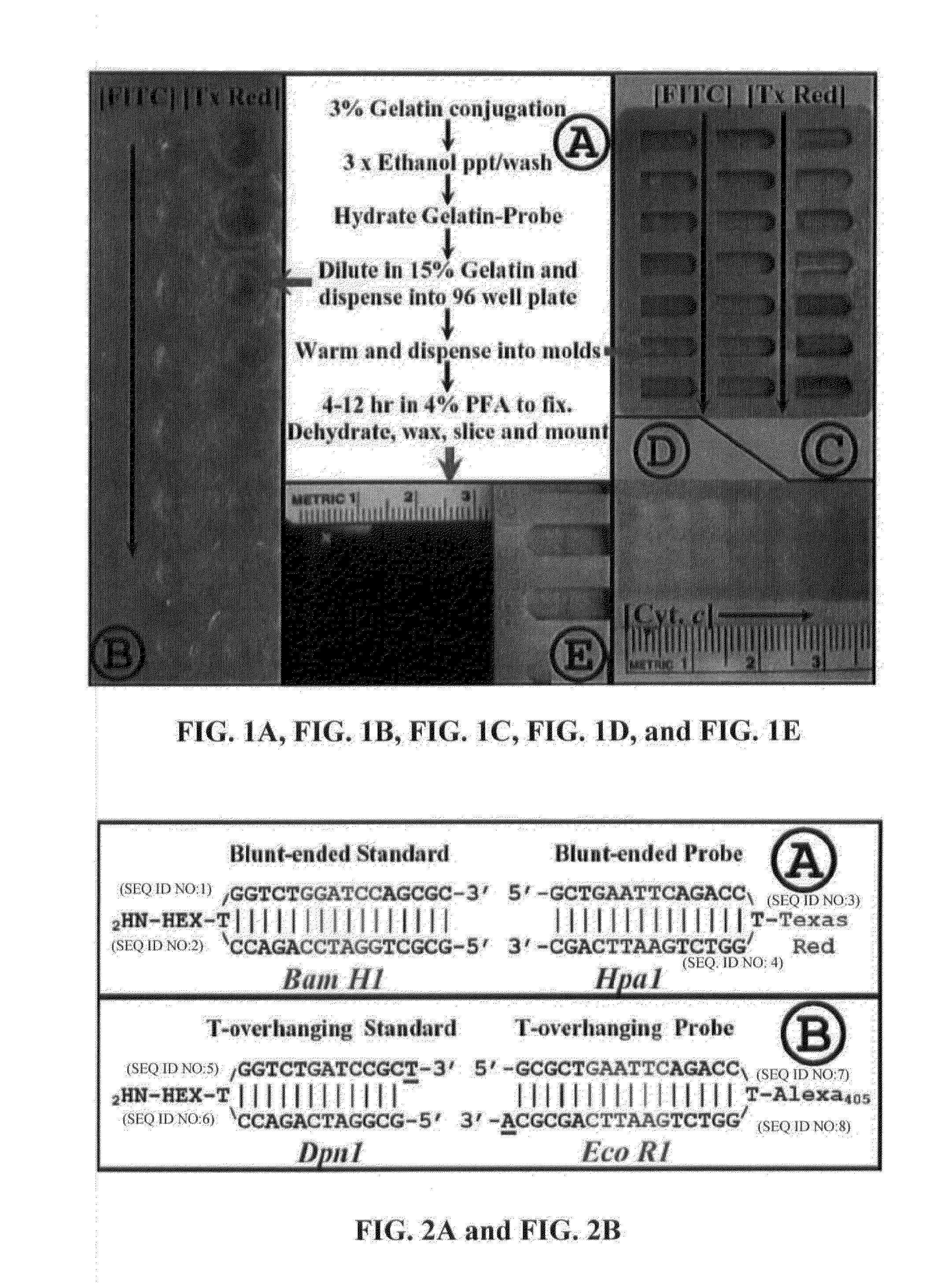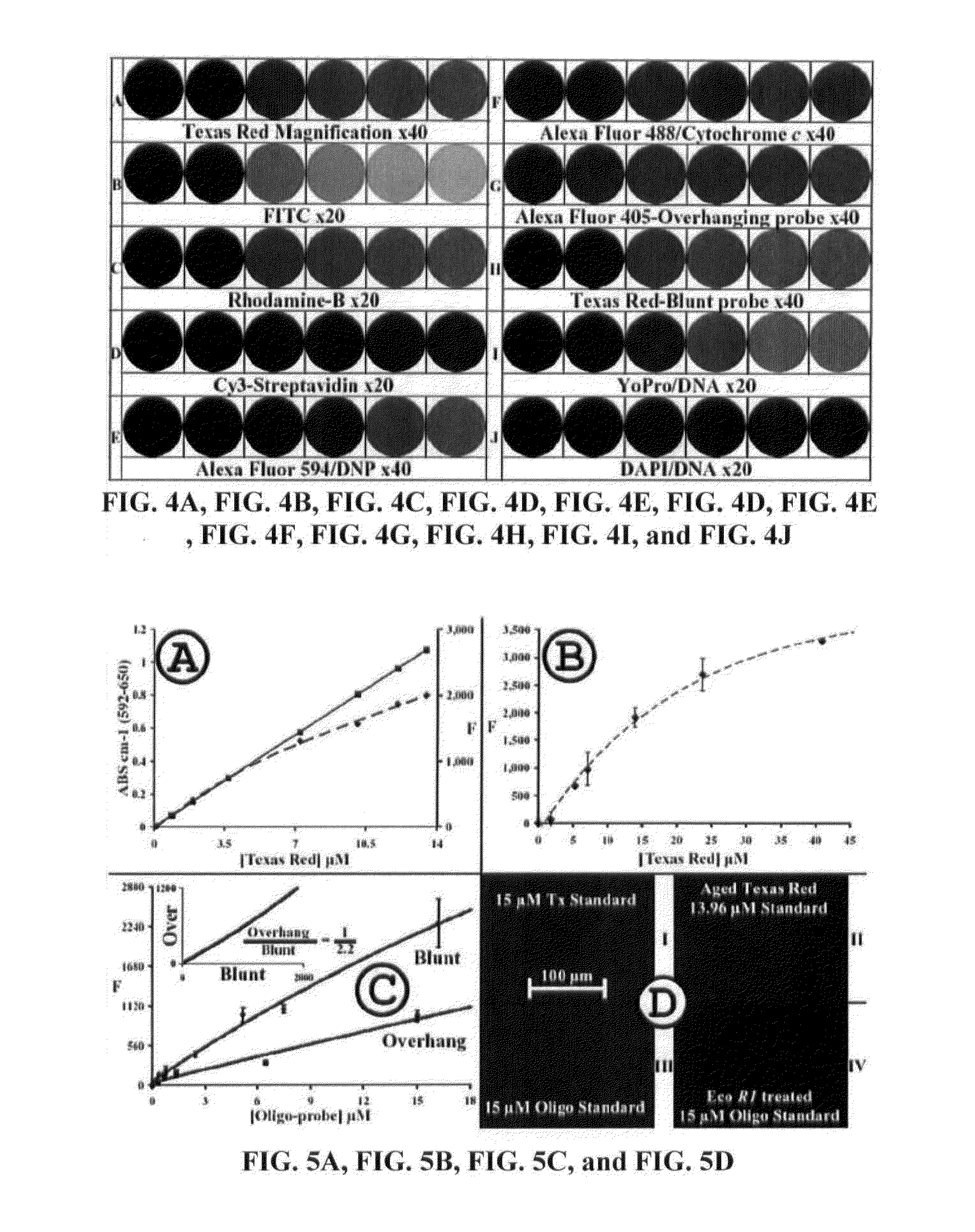Compositions and Methods for Quantitative Histology, Calibration of Images in Fluorescence Microscopy, and ddTUNEL Analyses
- Summary
- Abstract
- Description
- Claims
- Application Information
AI Technical Summary
Benefits of technology
Problems solved by technology
Method used
Image
Examples
example 1
Preparation of FITC-Labeled Gelatin Phantoms; Identification and Calibration of Images in Fluorescence Microscopy
[0061]Fluorescently-labeled, oligonucleotide probes have been developed, which can be used, inter alia, to study programmed cell death, or for visualizing the presence of different types of DNA breaks (see, e.g., Didenko et al., 2006; Didenko et al., 2004; Baskin et al., 2003; Didenko et al., 2003; Didenko et al., 2002; Didenko, Ngo and Baskin, 2002; Didenko et al., 1999) in a biological sample. This methodology was facilitated by the development of tissue “phantoms” that contain known amounts of: 1) one or more chromophores or fluorophores; 2) one or more nucleic acids (e.g., a DNA, an RNA, or any combination thereof); 3) one or more peptides, proteins, polypeptides, enzymes, and / or antibodies (either labeled or unlabeled), or any combination thereof; 4) one or more oligonucleotide standards (either DNA, RNA, or any combination thereof); or 5) any combination of one or m...
example 2
Direct and Quantitative Measurement of Blunt and Overhanging DNA Ends
[0135]The present example describes a method of quantifying the levels of blunt- and overhanging-DNA ends using a method that employs oligonucleotide standards bound to gelatin slices. Using these tissue ‘phantom’ standards, a ligating efficiency of essentially 100% and a background staining level of 2O2 and Paraquat), or to one of the three chemotherapeutic agents routinely used for treating this disease (carmustine [BCNU], temozolomide, or irinotecan) have also been characterized.
[0136]The present ligase-based assay for selective detection of specific markers of necrosis / apoptosis in tissue sections utilizing oligonucleotide probes employs biotinylated, oligonucleotide, hairpin probes to detect the products of internucleosomal enzymatic DNA cleavage. Both blunt- and overhanging-DNA 3′-OH ends were detectable, and the typical products of DNase I type activity using in situ labeling of double-stranded DNA breaks. T...
example 3
Quantification of DNase Type I and II Ends and Oxidized / Acylated Bases
[0165]In the present example, a quantitative assay has been developed by substituting labeled ddUTP in place of dUPT in the conventional TUNEL assay, and a protocol developed to permit, for the first time, a TUNEL-based assay to be used in a quantifiable manner. The inventors are also the first to demonstrate how such a ddTUNEL assay can be combined with phosphatase treatment to detect and specifically quantitate the levels of DNase Type II activity in a single sample.
[0166]The ddTUNEL assay described herein has been combined with the base-modification repair enzyme, formamidopyrimidine-DNA glycosylase (Fpg), to interrogate the levels of modified DNA in tissues or in fixed, cultured cells. Using rat mammary gland, from Days 1 and 7 of involution, the inventors have validated the new methodology's ability to label apoptotic nuclei and apoptotic inclusion bodies. In addition, the types of DNA damage and modification...
PUM
| Property | Measurement | Unit |
|---|---|---|
| Fraction | aaaaa | aaaaa |
| Fraction | aaaaa | aaaaa |
| Concentration | aaaaa | aaaaa |
Abstract
Description
Claims
Application Information
 Login to View More
Login to View More - R&D
- Intellectual Property
- Life Sciences
- Materials
- Tech Scout
- Unparalleled Data Quality
- Higher Quality Content
- 60% Fewer Hallucinations
Browse by: Latest US Patents, China's latest patents, Technical Efficacy Thesaurus, Application Domain, Technology Topic, Popular Technical Reports.
© 2025 PatSnap. All rights reserved.Legal|Privacy policy|Modern Slavery Act Transparency Statement|Sitemap|About US| Contact US: help@patsnap.com



